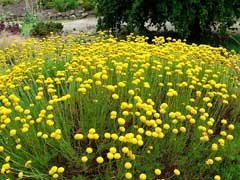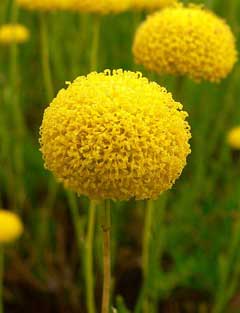 |
|
http://commons.wikimedia.org/wiki/User:Stan_Shebs |
 |
| http://commons.wikimedia.org/wiki/User:Stan_Shebs |
Translate this page:
Summary
Physical Characteristics

 Santolina rosmarinifolia is an evergreen Shrub growing to 0.5 m (1ft 8in) by 1 m (3ft 3in).
Santolina rosmarinifolia is an evergreen Shrub growing to 0.5 m (1ft 8in) by 1 m (3ft 3in).
See above for USDA hardiness. It is hardy to UK zone 7. It is in leaf all year, in flower from July to August. The species is hermaphrodite (has both male and female organs) and is pollinated by Insects.
Suitable for: light (sandy) and medium (loamy) soils, prefers well-drained soil and can grow in nutritionally poor soil. Suitable pH: mildly acid, neutral and basic (mildly alkaline) soils. It cannot grow in the shade. It prefers dry or moist soil and can tolerate drought.
UK Hardiness Map
US Hardiness Map
Synonyms
S. virens.
Plant Habitats
Hedge; South Wall. In.
Edible Uses
Edible Parts: Flowers Leaves
Edible Uses: Condiment Drink Tea
Holy Flax leaves are added to savoury Mediterranean dishes and to cocktails to add an olive-like flavour. Small quantities set off sweet dishes with the olive flavour. The flowering parts are used in herbal tea.
References More on Edible Uses
Medicinal Uses
Plants For A Future can not take any responsibility for any adverse effects from the use of plants. Always seek advice from a professional before using a plant medicinally.
None known
References More on Medicinal Uses
The Bookshop: Edible Plant Books
Our Latest books on Perennial Plants For Food Forests and Permaculture Gardens in paperback or digital formats.

Edible Tropical Plants
Food Forest Plants for Hotter Conditions: 250+ Plants For Tropical Food Forests & Permaculture Gardens.
More

Edible Temperate Plants
Plants for Your Food Forest: 500 Plants for Temperate Food Forests & Permaculture Gardens.
More

More Books
PFAF have eight books available in paperback and digital formats. Browse the shop for more information.
Shop Now
Other Uses
Hedge Hedge
Can be grown as a low formal hedge and used as an edging plant[200]. The plant is very tolerant of shearing[200]. Perennial groundcover for zone 2 firebreaks. The US government has created a system of firebreaks for areas prone to wildfires, theses are separated into concentric zones surrounding buildings. Zone 2 is the second away from the house. These low-level groundcovers provide little fuel.
Special Uses
Ground Cover Hedge Hedge Scented Plants
References More on Other Uses
Cultivation details
Does not require a rich soil and dislikes wet conditions around the roots[200]. Prefers a light sandy soil in full sun[200]. Established plants are drought tolerant[200], growing well in a hot dry soil[190]. Plants grow well in the cracks of a south-facing wall that contains pockets of soil[K]. This species is not very frost tolerant and is only hardy in the milder areas of Britain[11]. This species is often confused in gardens with S. pinnata neopolitanum[1]. There are some named forms, selected for their ornamental value[29, 200]. The flowers smell vile[190]. Tolerates shearing so long as this is not done at times of low resistance (winter?)[200]. Plants can be cut back hard in spring to maintain their form[200]. Plants in this genus are notably resistant to honey fungus[200]. Heat zone: 9-6. The cultivar ‘Lemon Fizz’ and the dwarf cultivar S. rosmarinifolia subsp. rosmarinifolia 'Primrose Gem' have gained the Royal Horticultural Society's Award of Garden Merit.
References Carbon Farming Information and Carbon Sequestration Information
Temperature Converter
Type a value in the Celsius field to convert the value to Fahrenheit:
Fahrenheit:
The PFAF Bookshop
Plants For A Future have a number of books available in paperback and digital form. Book titles include Edible Plants, Edible Perennials, Edible Trees,Edible Shrubs, Woodland Gardening, and Temperate Food Forest Plants. Our new book is Food Forest Plants For Hotter Conditions (Tropical and Sub-Tropical).
Shop Now
Plant Propagation
Seed - sow spring in a greenhouse. Does not require pre-treatment[113]. Prick out the seedlings into individual pots when they are large enough to handle and grow them on in the greenhouse for their first winter. Plant them out in late spring or early summer of the following year. Cuttings of half-ripe side shoots, 5 - 8 cm, July/August in a frame. Roots within 2 weeks. High percentage[78]. Division in spring or autumn[111]. Larger divisions can be planted out direct into their permanent positions. We have found it best to pot up the smaller divisions and grow them on in a lightly shaded position in a cold frame, planting them out once they are well established in the summer. Layering.
Other Names
If available other names are mentioned here
Holy Flax, Wadi Tops, Olive Herb. Manzanilla Blanca.
Native Range
EUROPE: Spain, France, Portugal
Weed Potential
Right plant wrong place. We are currently updating this section.
Please note that a plant may be invasive in one area but may not in your area so it's worth checking.
Conservation Status
IUCN Red List of Threatened Plants Status :

Growth: S = slow M = medium F = fast. Soil: L = light (sandy) M = medium H = heavy (clay). pH: A = acid N = neutral B = basic (alkaline). Shade: F = full shade S = semi-shade N = no shade. Moisture: D = dry M = Moist We = wet Wa = water.
Now available:
Food Forest Plants for Mediterranean Conditions
350+ Perennial Plants For Mediterranean and Drier Food Forests and Permaculture Gardens.
[Paperback and eBook]
This is the third in Plants For A Future's series of plant guides for food forests tailored to
specific climate zones. Following volumes on temperate and tropical ecosystems, this book focuses
on species suited to Mediterranean conditions—regions with hot, dry summers and cool, wet winters,
often facing the added challenge of climate change.
Read More
Expert comment
Author
L.
Botanical References
11200
Links / References
For a list of references used on this page please go here
Readers comment
© 2010, Plants For A Future. Plants For A Future is a charitable company limited by guarantee, registered in England and Wales. Charity No. 1057719, Company No. 3204567.